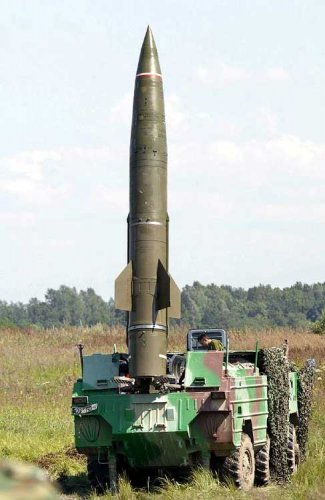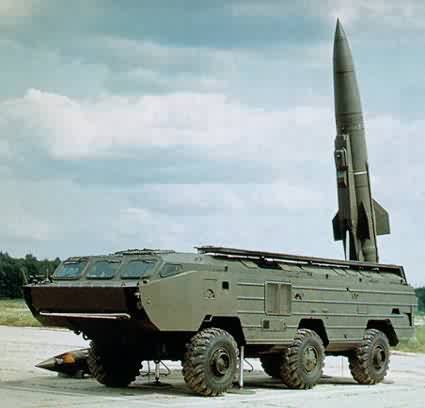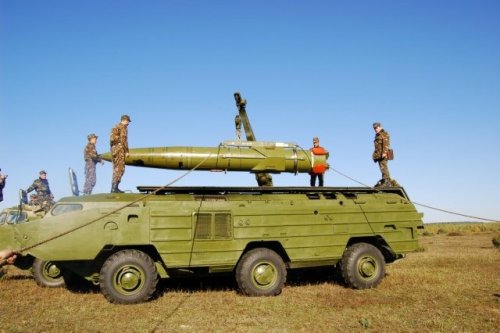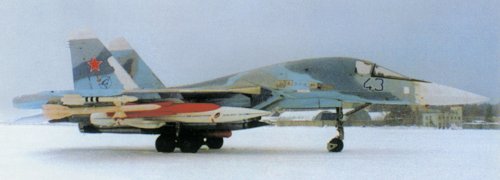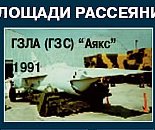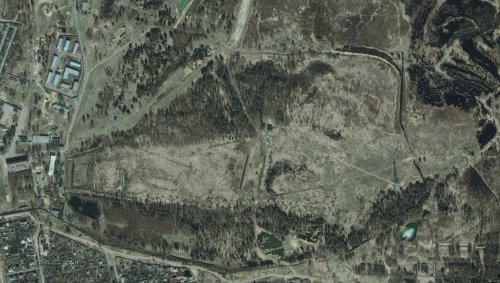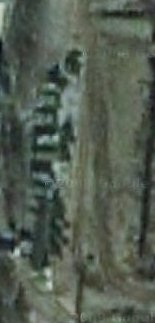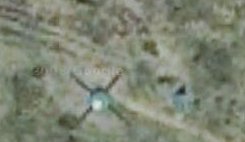You are using an out of date browser. It may not display this or other websites correctly.
You should upgrade or use an alternative browser.
You should upgrade or use an alternative browser.
Soviet Stealth: Research and Application
- Thread starter overscan (PaulMM)
- Start date
-
- Tags
- cold war radar soviet union stealth ussr
- Joined
- 1 April 2006
- Messages
- 11,369
- Reaction score
- 10,176
LowObservable said:And what's that THING in the lower left corner?
9K79-1 Tochka-U aka SS-21 " Scarab" http://www.new-factoria.ru/missile/wobb/tochka/tochka.shtml
Attachments
- Joined
- 1 April 2006
- Messages
- 11,369
- Reaction score
- 10,176
Trident said:the bottom right pic most certainly does not show a Kh-15 (I recognise the weapon but the name escapes me right now).
Looks like this mysterious (dummy) airbreathing NPO Mashinostroyeniya (NPOMash) missle shown together with T-10B-2 ca.1993. It was dubbed Alfa, but Alfa name is now tied with OKB Novator air-launched Club variants. It was 90s project of Chelomey's ancestor, Herbert Efremov.
http://nuclearthreatinitiative.org/db/missile/1996/m9606902.htm
Plotting A Revolution For Russia's Air Force - Jane's Defence Weekly, 31 July 1996, pp. 24-25, by Piotr Butowski
Two months after the air show, the Su-27IB was displayed with its weapon systems at the Zhukovsky test center near Moscow. The weapons displayed included a mock-up of the 300km-range NPO Mashinostroyeniya Alfa air-to-surface missile. The design bureau released general information on the Alfa in 1993. The missile is capable of Mach 3 and is designed to attack both ground and sea targets. The Alfa flies at an altitude of 10-20m during the final stages of its flight. Because the Novator Design Bureau has a missile called AFM-l Alfa, the term Alfa is probably a codename for the Russian requirement for this type of weapon system. NPO Mashinostroyeniya's Alfa is referred to as a unified system because it can be launched from virtually any platform, including submarines (with the option of vertical launch), ships, self-propelled ground launchers, and aircraft. The system is also referred to as universal because it can be used against a variety of targets, even in a "strong jamming environment." The missile employs an inertial-guidance system during the initial phase of its flight with information updates from a satellite-based navigation system. During the terminal phase, a multi-spectral homing head guides the missile to the target. A ramjet with a "ventral rectangular air-inlet" powers the missile and take-off boosters are required for the ship- and battery-launched variants. The Alfa has a cruciform tail and a small delta wing.
It wa also in AWST, but I don't have this issue with me now
Sukhoi offers Su-32FNs for export market. - Aviation Week & Space Technology 1995, v143n9, Aug 28, p. 25-26
Attachments
- Joined
- 1 April 2006
- Messages
- 11,369
- Reaction score
- 10,176
Meteorit said:flateric said:Note also that Kh-90 GELA directly linked to AJAX. ???
But are you sure this means the MHD hypersonic vehicle "Ajax" and not the name of GELA that just happens to be the same? Just wondering myself too...
Well, I'm quite sure I still can read my native language)))
Tuomasn
ACCESS: Secret
- Joined
- 5 January 2006
- Messages
- 477
- Reaction score
- 357
flateric said:Meteorit said:flateric said:Note also that Kh-90 GELA directly linked to AJAX. ???
But are you sure this means the MHD hypersonic vehicle "Ajax" and not the name of GELA that just happens to be the same? Just wondering myself too...
Well, I'm quite sure I still can read my native language)))
Sorry, I must have missed this part in the original article. Can you post the excerpt where it says this?
- Joined
- 1 April 2006
- Messages
- 11,369
- Reaction score
- 10,176
2nd TsNII RCS test range. Note radars line and rotating structure.
http://wikimapia.org/#lat=56.882153&lon=35.9475446&z=16&l=1&m=s&v=1
Gomparing to Tejon Canyon and Helendale...well, a little bit non-U
http://wikimapia.org/#lat=56.882153&lon=35.9475446&z=16&l=1&m=s&v=1
Gomparing to Tejon Canyon and Helendale...well, a little bit non-U
Attachments
- Joined
- 27 December 2005
- Messages
- 17,713
- Reaction score
- 26,191
I think Meteorit is just wondering if GELA picture caption happens to be referring to a different "Ajax" to the hypersonic "Ajax". Codenames were routinely reused in the USSR.
Tuomasn
ACCESS: Secret
- Joined
- 5 January 2006
- Messages
- 477
- Reaction score
- 357
flateric said:Well, I don't know, where are you looking exactly...but here it is
Well, of course I too can read that.
- Joined
- 6 August 2007
- Messages
- 3,875
- Reaction score
- 5,870
flateric said:2nd TsNII RCS test range. Note radars line and rotating structure.
http://wikimapia.org/#lat=56.882153&lon=35.9475446&z=16&l=1&m=s&v=1
Gomparing to Tejon Canyon and Helendale...well, a little bit non-U
51.617863° 39.113268° is a little more like western RCS ranges, but only a little.
is there anything more available about this "bolt-on plasma stealth" concept? like size, bulk, how it would be powered, etc?dickie said:sorry to bump an old thread, but i found this and didnt see it posted anywhere on the site yet - thought it may be relevent if anyone was to want the info.
http://www.aeronautics.ru/plasma04.htm
"A Russian scientific research organisation is to offer for export a 'bolt-on' stealth device that it claims renders non-stealthy aircraft practically invisible to radar. The system, which envelops the aircraft in a cloak of ionised gas known as a plasma, is said to be fully developed, with work on a "third-generation visibility-reduction system" under way.
Keldysh NITs (Nauchno-Issledovatelskiy Tsentr or Scientific Research Centre) is making the claims. According to its director, Anatoliy Koroteyev, the system weighs less than 100kg and consumes little more than several dozen kW of power.
Given the state of the Russian economy, analysts consider it unlikely that any of NITs' work has been applied to Russian Air Force aircraft. According to Koroteyev, however, the system will soon be offered for export.
By installing the system, a typical aircraft radar cross-section (RCS) might be cut "by more than 100 times", Keldysh NITs officials said. This would be much the same RCS as dedicated US stealth aircraft such as the Lockheed Martin F-117 stealth fighter and the Northrop Grumman B-2 stealth bomber.
The claims are given credence by corroborating information on the status of Russian aerospace plasma research acquired by Jane's Defence Weekly last year. Russian work in the use of plasmas that purported to reduce aircraft drag by as much as 30% was collated by British Aerospace (BAe) in the mid-1990s. BAe has since been trying to verify the Russian claims in experiments carried out jointly with the UK Defence Evaluation and Research Agency (DERA) and the UK Ministry of Defence (JDW 17 June 1998).
One of the spin-offs of 'plasma aerodynamics', Russian officials told BAe, was that it vastly reduced an aircraft's RCS. The absorption of radio waves by plasmas is well known as the communications black-out that a space vehicle encounters on re-entry is caused by the shielding effects of plasma. This builds naturally in front of the spacecraft as it hits the Earth's atmosphere and shocks the air to high temperature.
The same principle applies to the absorption of radar energy. Although the aircraft would appear to glow like a lightbulb, using plasma generators all around the airframe, it would be almost invisible on a radar screen, Russian officials maintain.
In the opinion of designers at Mikoyan and Sukhoi, the expense of all-embracing low-observable technology as applied in the US Air Force's F-117 and B-2 outweighs its effectiveness. Russians prefer to stress the 'balance' achieved in their latest-generation of fighter designs between aerodynamic efficiency and stealth. The Mikoyan 1-44 and Sukhoi S-37 technology demonstrators, both of which have been rolled out in the past 18 months, are supposed to make use of radar-absorbent paint and materials but are short of inherent stealth features.
Keldysh NITs said that "first- and second-" generation plasma-generators had been tested on the ground and in flight. The centre is working on a third-generation system "based on new physical principles", a possible reference to the use of electrostatic energy around an airframe to reduce RCS. Others believe the Russians could be attempting to duplicate secret work under way in the USA to make aircraft invisible to the human eye by using 'smart skins' that mimic their background."
(source: Jane's Defence Wekly, March 17, 1999)
- Joined
- 1 April 2006
- Messages
- 11,369
- Reaction score
- 10,176
you just need to replace 'Sam Taylor' with 'Anatoly Koroteyev'
http://www.youtube.com/watch?v=PHP3Jih_rfA
http://www.youtube.com/watch?v=PHP3Jih_rfA
pathology_doc
ACCESS: Top Secret
- Joined
- 6 June 2008
- Messages
- 1,587
- Reaction score
- 1,507
So if you're going to mask RCS with "plasma" - isn't that just trading one vulnerability for another??
"Comrades, we have invented weapon invisible to radar. Only problem is, AIM-9B missile can lock on from front aspect at fifteen miles."
"Comrades, we have invented weapon invisible to radar. Only problem is, AIM-9B missile can lock on from front aspect at fifteen miles."
- Joined
- 24 January 2006
- Messages
- 1,321
- Reaction score
- 466
Plasma stealth, if it works on an entire airframe, is best suited as a form of "active ECM". Pop it on when you get an AMRAAM seeker head hit on your RWR gear, and get away from the missile. Otherwise you have two potential problems: 1) you've become a huge IR target, and 2) if you envelope your whole airframe, guess what...you probably aren't sending out any radar signals of your own, either. You can get around the latter I guess, if you leave the radome uncovered and mount a planar array at an offset angle to act as a large faceted surface.
- Joined
- 15 July 2007
- Messages
- 4,878
- Reaction score
- 4,529
Now I seem to reccal plasma can be induced to radiate in the radio end of the spectrum.
In fact I seem to reccal there was even a radar based on this, that was studied for some application.
Course memory is a bit a dodgy, but it would be a highly embarassing thing to sheath your airplane in plasma only for for evil enemy to turn your 'cloak of radar invisibility' into a airplane enveloping radio beacon.
In fact I seem to reccal there was even a radar based on this, that was studied for some application.
Course memory is a bit a dodgy, but it would be a highly embarassing thing to sheath your airplane in plasma only for for evil enemy to turn your 'cloak of radar invisibility' into a airplane enveloping radio beacon.
A
AAAdrone
Guest
SOC said:, if it works on an entire airframe, is best suited as a form of "active ECM". Pop it on when you get an AMRAAM seeker head hit on your RWR gear, and get away from the missile. Otherwise you have two potential problems: 1) you've become a huge IR target, and 2) if you envelope your whole airframe, guess what...you probably aren't sending out any radar signals of your own, either. You can get around the latter I guess, if you leave the radome uncovered and mount a planar array at an offset angle to act as a large faceted surface.
That's pretty much the way it works as far as I know. It requires power to generate that plasma to sheathe your aircraft and the point of American Stealth is to not let huge amounts of energy leak out everywhere since doing so would set off enemy RWRs and IRSTs. Hence, it would be foolish to keep it on all the time because anyone with an IRST/IIR missile combo could lock you up from one heck of a distance. That and like you said you can't use radar either.
http://air-attack.com/page/19
According to this link Plasma stealth can apparently be used to generate false signals as well as absorbing enemy radar signals so I guess it can work as a DRFM jammer as well.
Given the disadvantages of keeping it on all the time this "plasma stealth" does seem to come off as an over glorified ECM suite.
Also, does anyone know how the Russians plan to power these plasma systems?
pathology_doc
ACCESS: Top Secret
- Joined
- 6 June 2008
- Messages
- 1,587
- Reaction score
- 1,507
Looks as though its best bet is a brief 'squirt' to break SARH or ARH missile lock and pull some radical G's or apply sideforce thrust in the hope of losing your pursuer before they can reacquire. Bad luck if said pursuer has a combined IR and radar homing capability (or your opponent has fired a pigeon pair of IR and radar homers at you).
A
AAAdrone
Guest
Then how is that "Stealth?" Why not just call it an ECM suite? The purpose of stealth is to never be detected in the first place so what's the point of plasma stealth if they can still detect/track you via IRST?
A
AAAdrone
Guest
What I'm saying is that since we were talking about using it only when a fire control radar has a lock on you then that isn't really stealth since you won't be having it on when going through hostile airspace guarded by early warning acquisition radars. In a sense I was equating it to over-glorified ECM since ECM is used against fire-control radars and missile radars.
You do have a point though in that it hides your position as opposed to confusing enemy radars with noise jamming but again considering an F-22 or F-35 is supposed to use its stealth characteristics to slip in between overlapping search radar coverage "bubbles" that would be impossible to slip into undetected with conventional fighters then how is a fighter with plasma stealth supposed to do the same? Is it going to turn on the plasma and waste power while performing similar maneuvers through hostile airspace?
You do have a point though in that it hides your position as opposed to confusing enemy radars with noise jamming but again considering an F-22 or F-35 is supposed to use its stealth characteristics to slip in between overlapping search radar coverage "bubbles" that would be impossible to slip into undetected with conventional fighters then how is a fighter with plasma stealth supposed to do the same? Is it going to turn on the plasma and waste power while performing similar maneuvers through hostile airspace?
Those "plasma effect" also can be seen naturally when MIRV or any other high speed object enter atmosphere. I read some test vehicle makes problems of tracking and emiting signals from itself cause of this effect.
AAAdrone said:What I'm saying is that since we were talking about using it only when a fire control radar has a lock on you then that isn't really stealth since you won't be having it on when going through hostile airspace guarded by early warning acquisition radars. In a sense I was equating it to over-glorified ECM since ECM is used against fire-control radars and missile radars.
You do have a point though in that it hides your position as opposed to confusing enemy radars with noise jamming but again considering an F-22 or F-35 is supposed to use its stealth characteristics to slip in between overlapping search radar coverage "bubbles" that would be impossible to slip into undetected with conventional fighters then how is a fighter with plasma stealth supposed to do the same? Is it going to turn on the plasma and waste power while performing similar maneuvers through hostile airspace?
Actually a plasma stealth plane could slip through a radar net just as well as a conventional stealth one. the difference is that plasma stealth would stand out on any thermal imagers in the area
- Joined
- 6 August 2007
- Messages
- 3,875
- Reaction score
- 5,870
mithril said:Actually a plasma stealth plane could slip through a radar net just as well as a conventional stealth one. the difference is that plasma stealth would stand out on any thermal imagers in the area
Not really. Plasmas are defined by the ionization, not their temperature. For these kinds of applications, they don't need to be "hot".
Resister1976
ACCESS: Confidential
- Joined
- 9 April 2021
- Messages
- 71
- Reaction score
- 46
Recently,somebody said that the stealth standards of Soviet fighter (such as S-37、Mig-I.44) is......
the front RCS:0.3m²
is it right?
the front RCS:0.3m²
is it right?
- Joined
- 6 August 2007
- Messages
- 3,875
- Reaction score
- 5,870
Is your question…Recently,somebody said that the stealth standards of Soviet fighter (such as S-37、Mig-I.44) is......
the front RCS:0.3m²
is it right?
1. Is 0.3m2 the target/intended RCS for those aircraft
Or
2. Is 0.3m2 the actual RCS for those aircraft
Resister1976
ACCESS: Confidential
- Joined
- 9 April 2021
- Messages
- 71
- Reaction score
- 46
1Is your question…Recently,somebody said that the stealth standards of Soviet fighter (such as S-37、Mig-I.44) is......
the front RCS:0.3m²
is it right?
1. Is 0.3m2 the target/intended RCS for those aircraft
Or
2. Is 0.3m2 the actual RCS for those aircraft
Resister1976
ACCESS: Confidential
- Joined
- 9 April 2021
- Messages
- 71
- Reaction score
- 46
……
Nobody answer me?
(0v0)
Nobody answer me?
(0v0)
,
Last edited:
Resister1976
ACCESS: Confidential
- Joined
- 9 April 2021
- Messages
- 71
- Reaction score
- 46
W…WTF?Minimum calculated RSC:
MiG 1.42 - 3.1 m2
Su-47 - 1.8 m2
F-22 - 0.35 m2
According to the authors of the well-known article by Lagarkov and Pogosyan, the RSC of a fifth-generation fighter cannot be lower than 0.3 m2 due to design features
text in Russian
siegecrossbow
I really should change my personal text
- Joined
- 12 March 2012
- Messages
- 706
- Reaction score
- 2,101
W…WTF?Minimum calculated RSC:
MiG 1.42 - 3.1 m2
Su-47 - 1.8 m2
F-22 - 0.35 m2
According to the authors of the well-known article by Lagarkov and Pogosyan, the RSC of a fifth-generation fighter cannot be lower than 0.3 m2 due to design features
text in Russian
Maybe this is the average RCS from all angles.
- Joined
- 11 February 2010
- Messages
- 1,643
- Reaction score
- 2,682
I would assume the calculation is based on statistical analysis. From what i read so far, the value one present to radar designer or air defense troops out there are statistics based on PDF (Probability Density Function) of the data.
So after measurement, the data is then fitted to many PDF or a PDF is made for the data set, which then the a value is drawn for. e.g 90% of the time one will find this value of RCS. For simple limited aspect analysis, Median is used. For maritime target RCS, apparently 90th Percentile of the RCS is used.
The Average value of RCS one typically seen in Chinese or Russian publications cannot be used directly in Radar range calculation. instead it can be used for PDF equation fits. There is also CDF or Cumulative Distribution Function, tho for this one i am not really sure how it should be used.
So after measurement, the data is then fitted to many PDF or a PDF is made for the data set, which then the a value is drawn for. e.g 90% of the time one will find this value of RCS. For simple limited aspect analysis, Median is used. For maritime target RCS, apparently 90th Percentile of the RCS is used.
The Average value of RCS one typically seen in Chinese or Russian publications cannot be used directly in Radar range calculation. instead it can be used for PDF equation fits. There is also CDF or Cumulative Distribution Function, tho for this one i am not really sure how it should be used.
Similar threads
-
-
-
Vladimir Sergeevich Ilyushin 31-03-1927 - 01-03-2010
- Started by flateric
- Replies: 4
-
-
Sergey Pavlovich Nepobedimy (September 13, 1921 – April 11, 2014)
- Started by flateric
- Replies: 3

